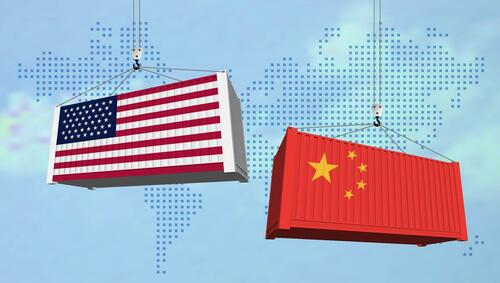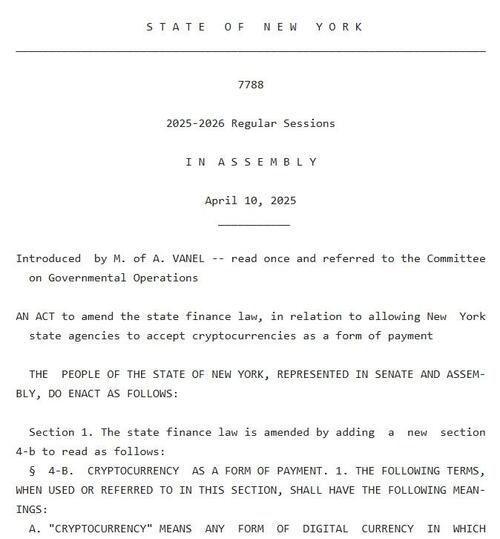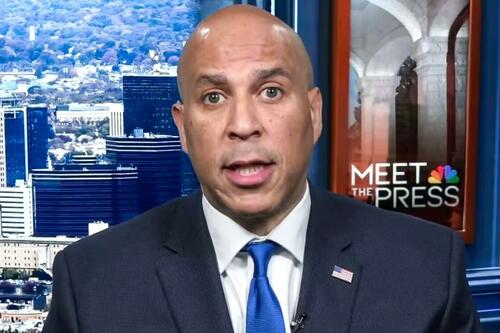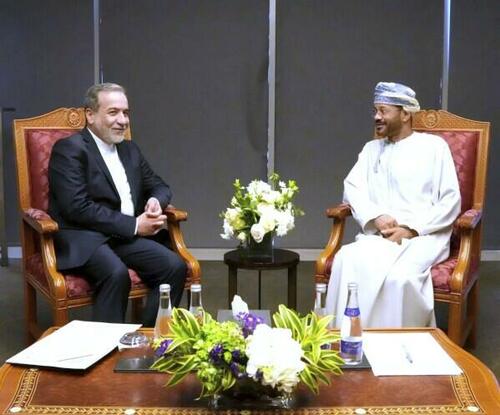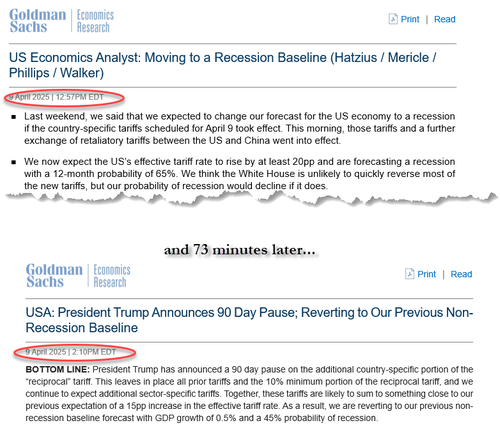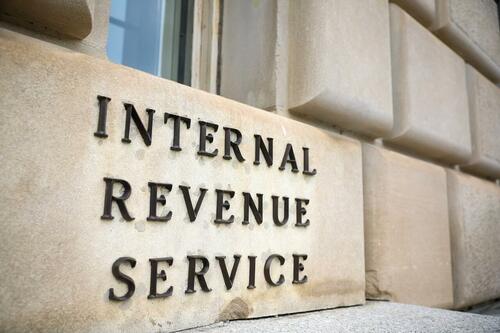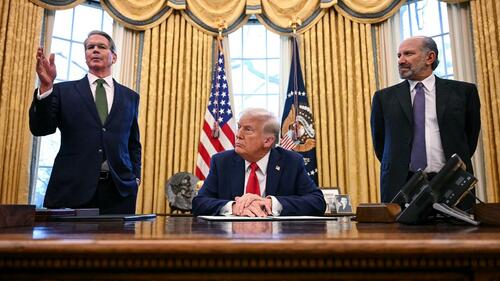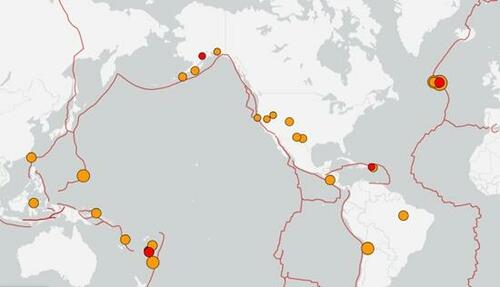China Would Lose A 'Trade War' With The US... "Gradually, Then Suddenly"
Authored by Victor Davis Hanson via American Greatness,
No one wants a “trade war” with China, or for that matter with any nation. Nonetheless, China has been waging one for years and is now locked in a tariff recalibration with the Trump administration.
In this American effort to find trade parity and equity, China can do some short-term damage to the U.S., especially in terms of ceasing exports of some pharmaceuticals, phones, and computers. But ultimately, it cannot win—and will eventually lose catastrophically. It will likely accept that reality sooner rather than later.
We are only in the first week of the escalating rhetoric and tariffs. But already China is appealing to its Asian rivals, Australia, and the EU to join in fighting the supposed American bully.
But so far, there are understandably few takers.
An exasperated China is now also running vintage Korean War-era propaganda videos of Mao Zedong bragging about how he was standing up to then-President Dwight Eisenhower.
Does Beijing really believe that airing ossified threats from decades ago—issued by the greatest mass killer in human history to the one U.S. president who warned of the military-industrial complex—is going to win over neutral nations?
Or maybe China thinks calls to Western nations to stop American trade “bullying” will resonate—this, from the greatest trade bully, cheat, and rogue commercial nation in history.
China is running a nearly $1-trillion trade surplus with the world. Its mercantilism is the result of market manipulations, product dumping, asymmetrical tariffs, patent, copyright and technology theft, a corrupt Chinese judicial system, and Western laxity—or what might be mildly called “bullying.” The U.S. accounts for about a third of China’s trade surplus, with most of the EU and Asian nations accounting for the other two-thirds.
In the past, third-party nations did not appreciate the ends to which China has gone to warp the international trading system. In one sense, unable to address their deficits with China, our friends and neutrals turned to America, where they sought to make up their trade asymmetries by going China-light and running surpluses with the U.S.
However much they criticize the United States, it is unlikely that European and Asian nations will join China—which imposes high tariffs and steals from them—in order to gang up on the U.S., which has tolerated massive trade deficits for decades.
To the degree that the world accepts China as an international commercial rogue nation, it does so out of fear —or, again, on the assumption it can recycle its deficits with Beijing by running surpluses with the vast open American market.
Countries like Panama, which once thought China’s Belt and Road Initiative was advantageous, soon learned that it was exploitative. Nothing is free with China. Its Silk Road policy is mostly designed to manipulate strategically located—and soon to be indebted and subservient—nations as future choke points in times of global tensions and is directed at the West in general and in particular the U.S.
China has done everything possible to incur global distrust and fear.
Most of the world accepts that the COVID-19 epidemic that killed and maimed millions worldwide was birthed in a Wuhan virology lab under the auspices of the People’s Liberation Army. The world also remembers that China and the Chinese-controlled WHO lied repeatedly about the origins and spread of the virus.
The global public may recall that China stopped all domestic flights out of Wuhan on the internal news of the lab leak of the virus, while for days greenlighting nonstop air travel to major European and American cities. The world now accepts that China will never explain exactly when the virus appeared, how it “escaped” from the lab, why it was created in the first place, why Beijing repeatedly lied about all such inquiries, and what happened to an array of whistleblowers who warned of the leak.
China’s so-called allies, such as Russia and India, have historical grievances and ongoing border disputes fueled by Chinese aggression.
NATO, the EU, Japan, South Korea, Australia, and the US also are curious as to why China is using its vast foreign exchange not to lift about a quarter of its population out of third-world-level poverty. Instead, it is frantically building 3-4 nuclear bombs a month, a 700-ship navy, and 2,500 combat aircraft as it ratchets up pressure on Taiwan.
The complexities of trade and tariffs present all sorts of minefields. But the Trump administration is beginning to navigate them, and its trajectory is rather simple. In the next 90 days, it will likely conclude trade deals with our allies and third parties that bring either tariff parity or no tariffs at all that will reduce the U.S. trade deficit.
Of course, our allies and neutrals still use stealth tariffs to ensure advantage by money manipulation, VAT taxes, and pseudo-health and security impediments to free trade. And they deeply resent the Trump administration’s loud denunciations of their surpluses and asymmetrical tariffs. But those machinations can be addressed later in round two after tariff reciprocity or elimination is finalized.
For now, Trump should persuade our allies that if they were not so subject to Chinese mercantilism, they would have more flexibility to ensure fair trade with the U.S. And thus, they should not do something self-destructive and side with China but instead join the U.S. to force China to keep its long-broken promises and play by international rules. A reduced import footprint from China in the U.S. could make room for increased imports from the EU, Japan, South Korea, and Taiwan—if they strike parity deals with the Trump administration. Barring that, they should simply get out of the way and not opportunistically cut reformist trade deals with China.
If China really does reduce most of its exports to the U.S., America will have to scramble for a year or so to establish new supply chains and some alternate importers of U.S. products. But after a year of gradual dislocation, China will begin to hemorrhage, and then quite suddenly, given the U.S. has almost all the advantages—if it chooses to use them.
-
One, if it ever comes to a real trade war, remember that nations with the higher tariffs and larger trade surpluses usually lose, given that their economies are far more dependent on mercantile exports and trade imbalances. Psychologically, it is far harder to convince the world of victimhood when tariffs and surpluses illustrate contrived trade aggression.
-
Two, consensual societies are far more flexible in dealing with external pressures and volatile public opinion. True, Trump must face a midterm election in 18 months. However, Xi Jinping may soon face a third of his export factory workforce unemployed—in a society that has no mechanism for them to vent tensions and objections peacefully.
-
Three, trillions of trade dollars are at stake as a result of the U.S.-China standoff. And should China escalate, it may well lose elsewhere as well. There are nearly 300,000 Chinese students here in the U.S. and now very few Americans in China—plus an unknown number of young Chinese males who mysteriously and illegally crossed the border en masse during the Biden illegal alien influx. A small percentage—but still a significant number, say 1%, or 3,000 “students”—are likely actively engaged in espionage. More importantly, thousands of PhDs and MAs return to China as now Westernized researchers, professors, and government and corporate scientists in technology, engineering, and mathematics.
The results of such technology absorption are not hard to fathom. Almost every Chinese jet fighter, armored vehicle, missile, or rocket; almost every EV automobile; and almost every solar panel have their origins in either U.S. and European research and development or from Western-trained Chinese engineers.
American universities recruit Chinese students and then often charge premium tuition without discounts or scholarships, but then again, universities are not especially popular now. The Trump administration may feel that if the trade war escalates, then it can always choose to recall visas from Chinese students—in the manner there were few Soviet Russian students in the U.S. during the Cold War. That step would serve a dual purpose by forcing universities to recalibrate their finances and cut their unnecessary or deleterious programs.
Almost every Western institution proves a source of Chinese dependency and vulnerability. Its secretive companies are freely listed on Western stock exchanges, even though their financial and earnings reports are most likely warped. Chinese companies could easily be dropped from these venues. They use Western courts to sue with the expectation of judicial equity, while no Western company in China has any such assurance. Chinese billionaires buy U.S. property, not vice versa.
In terms of self-sufficiency, the U.S. is the world’s largest oil and gas producer. China has four times America’s population but only a third of its oil and gas production. China is desperately trying to catch the U.S. militarily but remains behind in both the quality and quantity of its manpower and munitions. It will take a decade or more to match the U.S. all-nuclear submarine fleet, eleven huge nuclear aircraft carriers, the sophistication and number of 4,000 fighters, bombers, and support aircraft, and the 5,000-6,000 nuclear weapons and the American nuclear triad delivery system.
Morally, China is the only major country that holds an entire ethnic minority—over a million Uyghurs—as virtual indentured servants. If China moves on Taiwan, it will face tough global sanctions. If the Ukraine war ends this year, there will be efforts by the Trump administration to adopt Kissingerian triangulation to see that Russia is no closer to China than to the U.S.
In sum, if the Trump administration can conclude first-round—good enough but not yet perfect— trade deals in the next few weeks with major EU countries, Japan, and other Asian and Pacific powerhouses, and then redirect to China, it will gain both political support and economic advantage. It also must message strategically, given that China, for a half-century, has waged a quiet trade war that has now birthed a loud reaction. So, the administration must remember that the current status quo is the aberration, and its correction is a return to normalcy.
After all, in the end, the EU and Asian nations should know the difference between their protective and rules-based ally, with whom they have run up huge and unfair surpluses, and a rogue bully, whose flagrant violations of trade norms and unfair tariffs have ensured them large trade deficits. And if they don’t calibrate their economic self-interest, but act emotionally, then they should at least consider realpolitik facts, such as which nation has the larger economy, the more open political system, and the largest and most lethal military that, in extremis, would come to their aid—against a bullying China.
https://ift.tt/JI9BA3a
from ZeroHedge News https://ift.tt/JI9BA3a
via IFTTT


